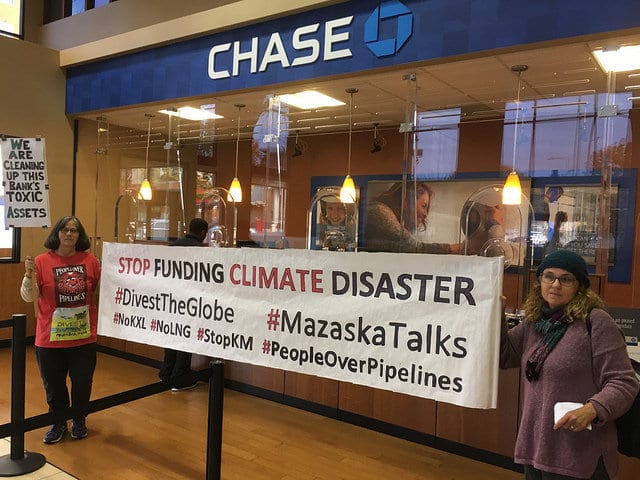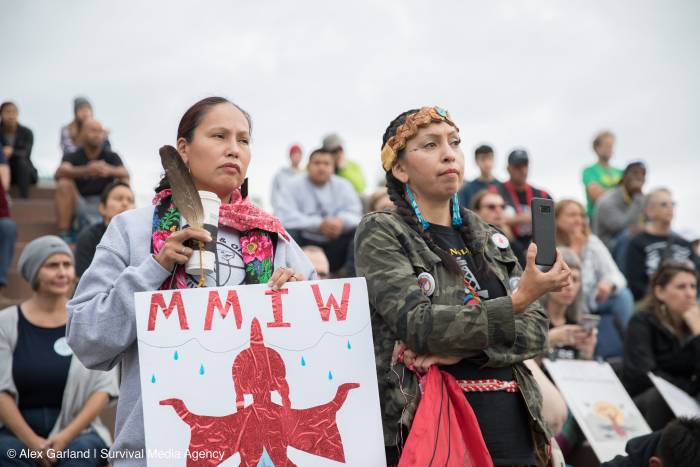Nonviolent Direct Action and 350 Seattle: An introduction
Earlier this year, 350 Seattle disrupted 44 Chase Bank branches in the Seattle area in coordination with 221 other actions around the country.
Nonviolent direct action (NVDA) plays a tremendous role in our movement, and this is especially true for 350 Seattle. Nonviolent direct action has been crucial to scoring major victories here in Seattle and in raising the profile of the fight against the fossil fuel industry.

In many cases throughout history, NVDA has been a tactic used strategically to shift the balance of power. The Civil Rights Movement is rich with examples of people, from whom social power was withheld, taking action to demand power and equality. Today, specifically in the climate movement, we engage in NVDA to tell powerful corporations and governments that we will no longer passively allow them to exploit our planet and communities for their profit.
This tactic helps tell the story in a different way. There is powerful imagery in thousands of people marching with signs. While that may convey the message you’re trying to send, it doesn’t quite capture the demand for a shift in the balance of power in the way that direct action does. And stories of people taking bold action, even voluntarily risking arrest to fight for justice, can often grow a movement by inspiring others to take action as well.
Fossil Fuel Infrastructure, Structural Racism, and NVDA
The fossil fuel industry and the movement for climate justice don’t exist in a vacuum. The oppression and inequities that are present throughout our society impact our work as well. Standing Rock was a huge eye-opener for many in realizing that often, fossil fuel infrastructure is built on or near Indigenous treaty land, and very often without the consent of the tribes living there.
Pipelines on Indigenous treaty land don’t just bring environmental destruction; they bring violence to Indigenous communities, especially to women and girls. We cannot talk about the environmental destruction of pipelines without also highlighting the issue of “man camps”. All along the routes of pipeline construction, Indigenous women and girls go missing and are murdered at an astounding rate.

As reservations fall under Bureau of Indian Affairs jurisdiction, local law enforcement rarely take any interest in these cases, leaving Indigenous people to fend for themselves, organize search parties, and hope that their family members make it home safely. According to the Department of Justice, the murder rate for Indigenous women and girls is ten times the national average.
Throughout the US, fossil fuel infrastructure also has a disproportionate impact on other communities of color. 68% of African Americans live within 30 miles of a coal-fired plant, along with 38% of Latinx Americans.
Considering Privilege and Power
Policing and incarceration plays a pivotal role in upholding structural racism in the US. For centuries, these institutions have worked to suppress movements for freedom led by people of color.
The only way to equitably plan and participate in NVDA in our movement is to consider how racism shapes how the police will treat us and our comrades, friends and allies.
That means that those with more privilege need to be willing to take more risks. White activists are less likely to be harmed or mistreated by police than non-white activists. Other factors, such as disability, immigration status and prior convictions, also need to be taken into consideration. An undocumented person could risk indefinite detainment and eventual deportation by participating in direct action, even if that direct action is nonviolent. Similarly, a person with prior convictions could face higher bail or more serious charges than those without a record. Thinking through these details is not only essential to properly caring for our fellow activists, it’s also good strategy.
Examples from 350 Seattle
350 Seattle’s first Pledge of Resistance activation happened in 2017. Organizers had been in conversation with Mazaska Talks, an Indigenous-led group focusing on the tactic of divestment from the big banks that propel fossil fuel development. We held two public action meetings to give context of the campaign and strategic reason for targeting Chase Bank – which provides project-level loans to tar sands pipelines. At these meetings, we informed participants about legal risks and potential outcomes, and organized them into action groups.
On May 8, 2017, 12 action groups shut down 13 branches in one afternoon (one location preemptively closed, which we considered an easy win). 26 people were arrested. We generated media, deepened conversation around divestment, and helped spark international interest in continued action against Chase Bank.
Mazaska Talks helped organize a broad coalition including Rainforest Action Network, various 350 chapters, and the Sierra Club to bring another wave of NVDA to Chase and other tar sands-funding banks in October 2017, which saw actions in over 60 cities, 10 countries and 4 continents. One of the films including in a list of NVDA resources at the end of this blog post, Arrestable, follows 350 Seattle activists getting ready for this #DivestTheGlobe action.
Since then, 350 Seattle has continued to build deeper relationships with Indigenous allies, including a connection with Missing and Murdered Indigenous Women. Another action targeting Chase Bank included two parts: Indigenous women, supported by women and femme allies, filled the lobby of the Russell Investment Center (home to Chase Bank’s Pacific Northwest HQ) in honor of Missing and Murdered Indigenous women, while activists outside quickly built four tarpees in the street, blocking traffic for 5 hours.
These tarpees, created for winter shelter at Standing Rock, were later destroyed by Seattle Police, and 15 people were arrested. This action made international headlines, helping to educate more people on the deep connection between bank investments and fossil fuel infrastructure, while highlighting the terror inflicted on the safety and well-being of Indigenous people.
This year, we took action against Chase once again, this time disrupting 44 branches across the city.
We all know climate crisis is here, and that those who can make the changes we need will not act on their own. Collectively, we have the power to stop the fossil fuel industry from destroying our climate and harming our communities. By leveraging people power through direct action and other key organizing tools, we can bring about a just transition to 100% renewable energy and a more equitable and sustainable future for everyone.
To change everything, we need everyone. The time to disrupt business as usual is here, and there are many roles to play in non-violent direct action.
To learn more, check out the short documentary, Arrestable, including a discussion guide you can use to support group conversation about the film and how NVDA might fit in with your ongoing organizing.
Arrestable Film & Arrestable Discussion Guide
Learn more with these resources:
Why Direct Action? 350 Seattle
Taking Leadership from the Most Impacted
When Normal People Get Together & Do Extraordinary Things
Letter from Birmingham City Jail: Excerpts (Martin Luther King, Jr)
MobLab: Bring on the People– Opening Up Non-Violent Direct Action
The Power of Nonviolent Direct Action
Hundreds of Poor People’s Campaign Activists Got Themselves Arrested for Racial Justice
Climate Politicking Isn’t Working: We Need Climate Civil Disobedience (Bill McKibben)